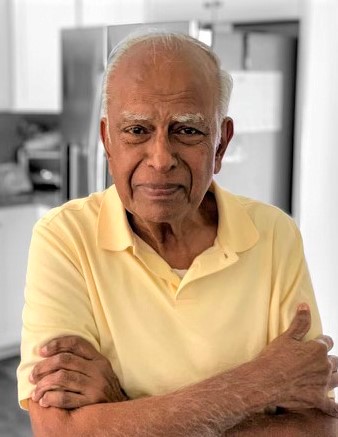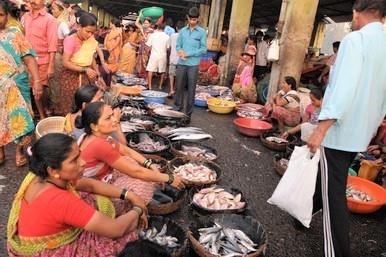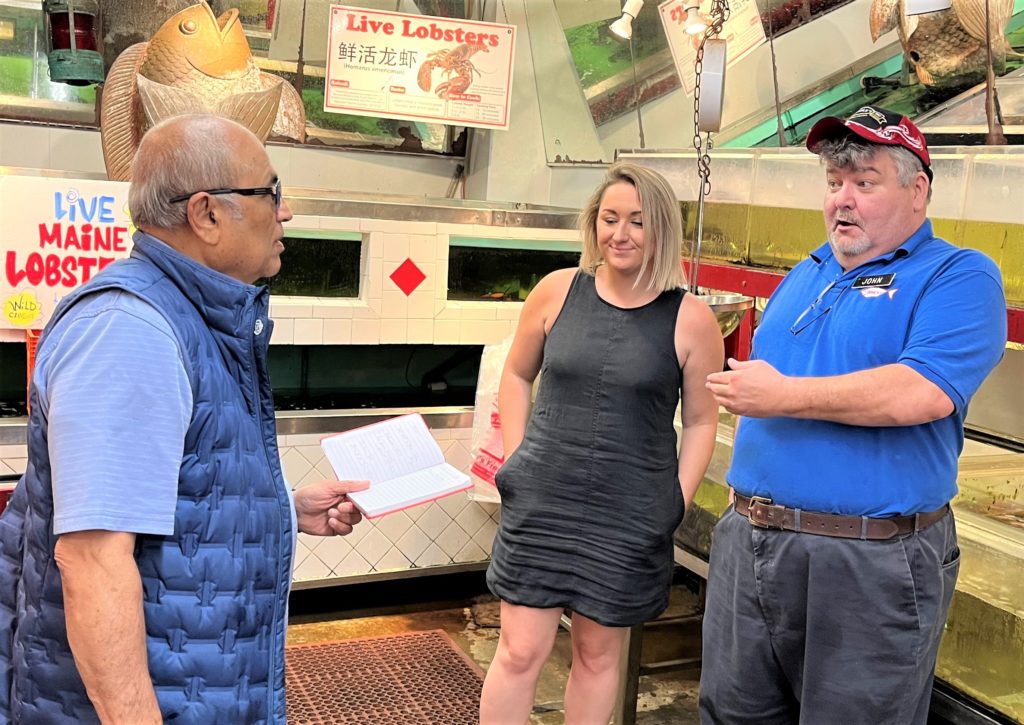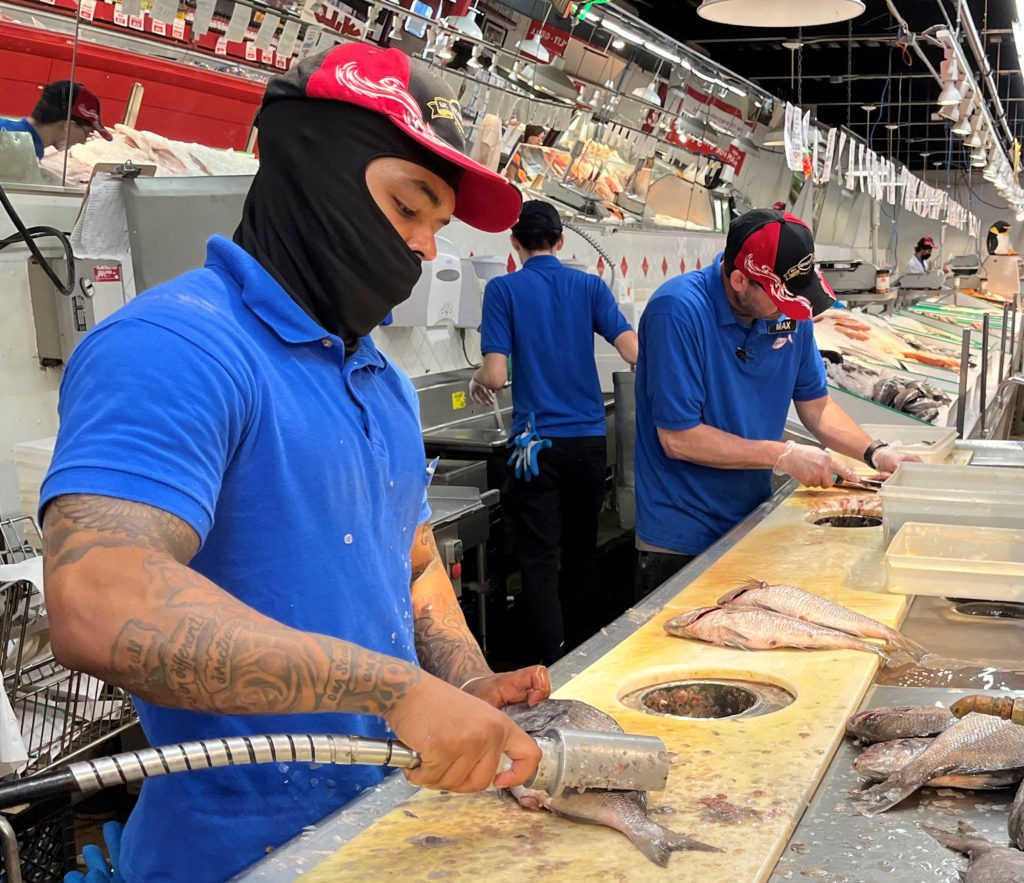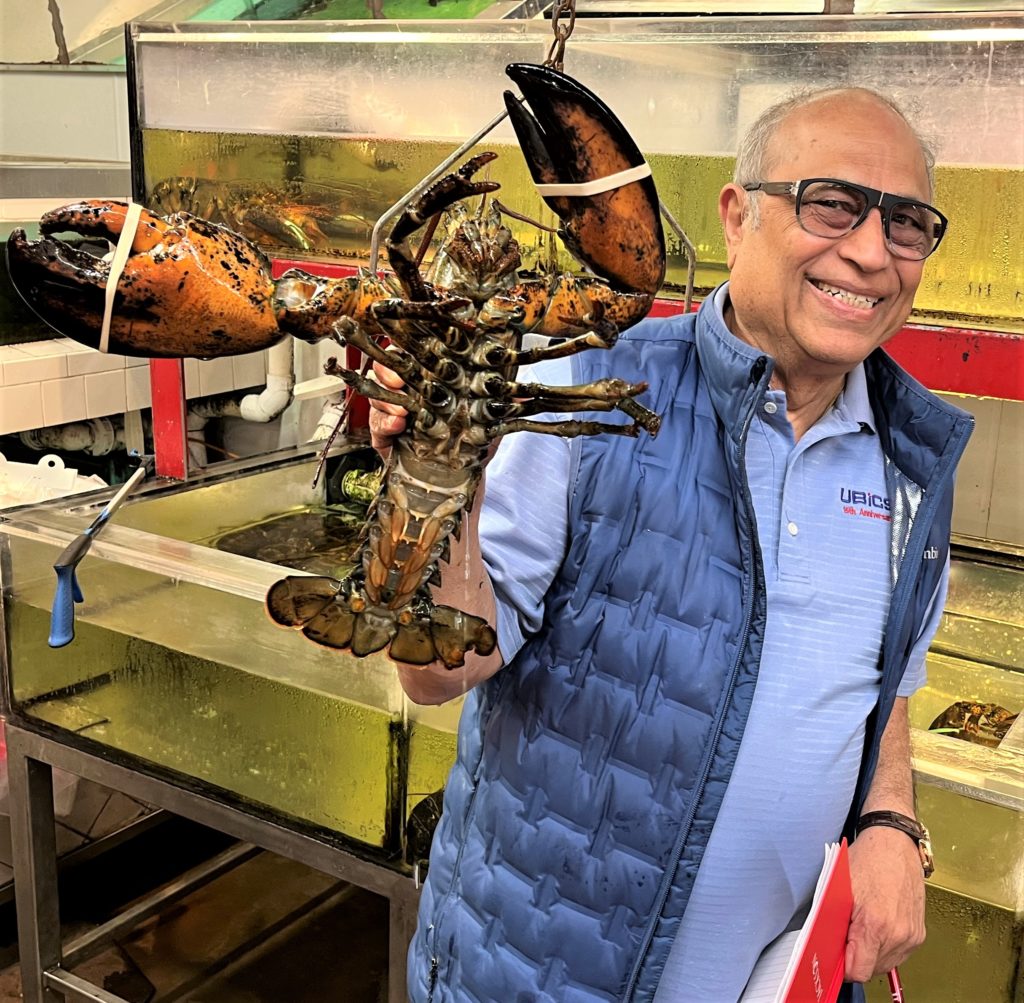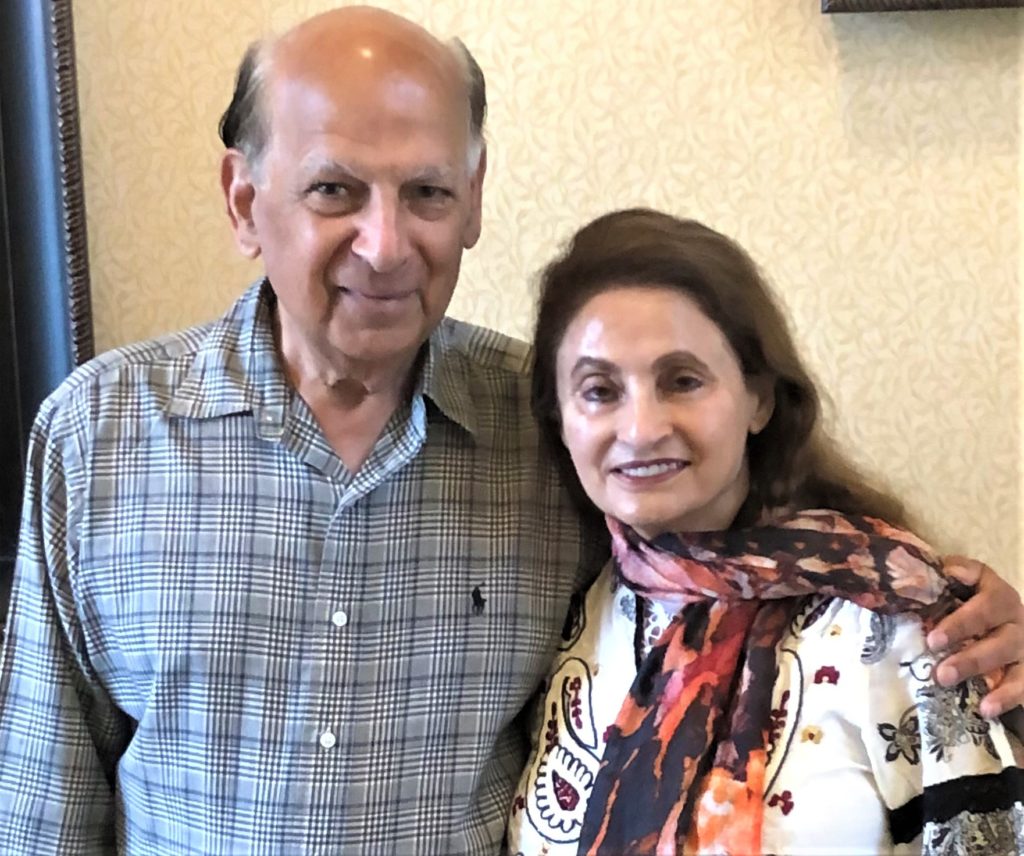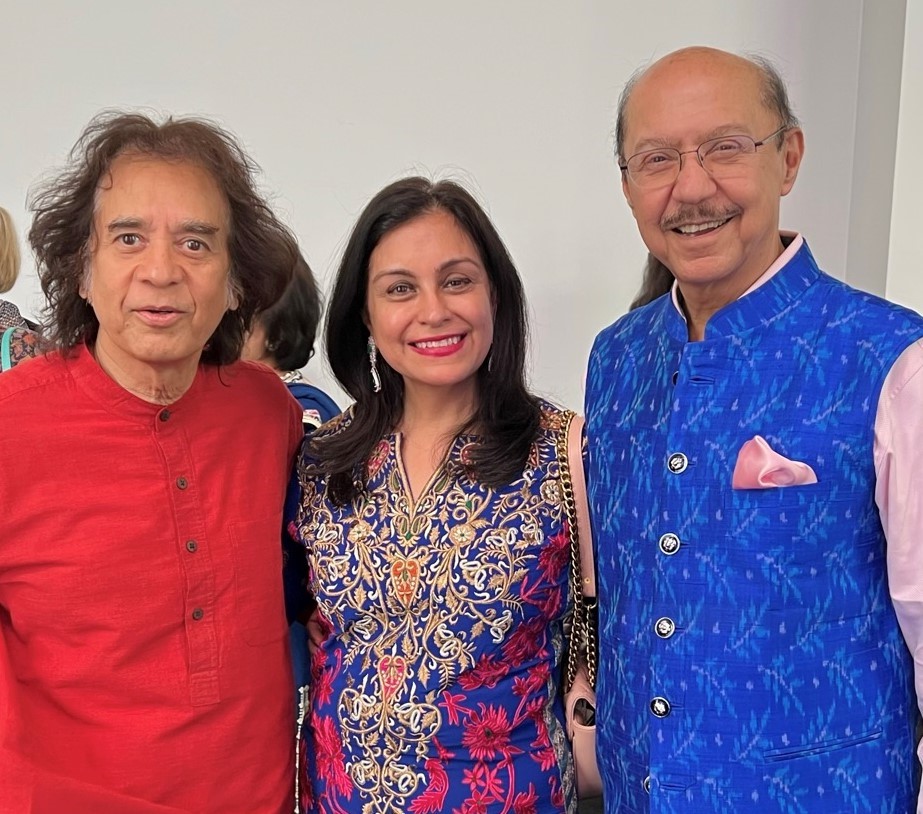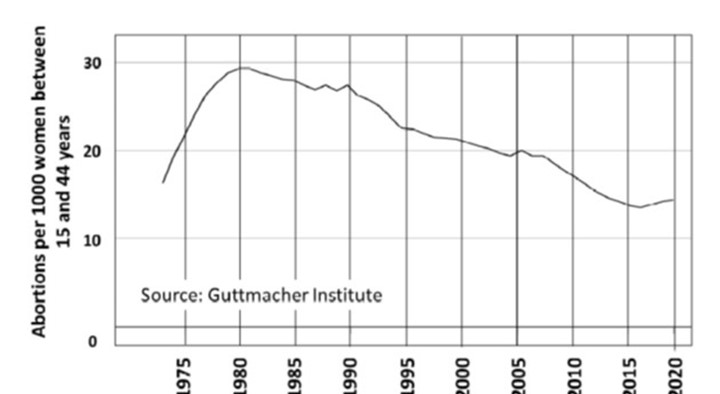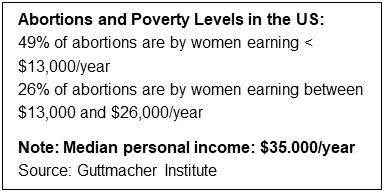Archive for category July 2022
The Difference Between the Old and the New
Posted by admin in July 2022, Past issues on July 7, 2022
From time immemorial in India, rivers have been used as a metaphor. Examples: Hinayanam (literally the Small Vehicle or Boat) and Mahayanam (Big Vehicle or Boat) in Buddhism, samsara sarovar (the sea of life), and teerthankaras (the Boatmen Who Help to Cross the River) are the Jain masters.
We have rivers all over India that people need to to cross over for going from anywhere to everywhere.
No wonder, Urdu poets too have used rivers and boats as metaphors in simple-sounding shers (two liners). Here is one by Akbar Allahabadi (1846-1921) that Harish Saluja sent me sometime back, also providing me with its translation:
The difference between old light and the new light is only this:
One can’t find the boat; the other can’t find the shore.
In Indian languages, there is more to any two-liner doha of shayiri than its literal translation. The light the poet talks about is insight. The “Old” has the insight to see the shore afar, but not the resources or the strength to reach there. And the “New” has the resources and strength, but does not know where the shore is. This is the ultimate paradox of life.
Bus Driver’s Error Takes Kerala Pilgrims to the Goa Beach 300 Kilometers Away
Posted by admin in July 2022, Past issues on July 7, 2022
Kerala could be the state with the highest literacy rate and better social indicators in the aggregate. But aggregate numbers do not tell about individuals as this story shows.
In May 2022, the Kerala State Transport Corporation introduced an air-conditioned sleeper bus service from its capital Tiruvananthapuram to Kolluru Mookambika temple, the famous Devi temple and pilgrimage destination for Keralites, north of Mangaluru in Karnataka. On the inaugural trip, on the coastal highway, late at night, the driver missed the exit to Mookambika temple and continued straight, not recognizing that he missed the exit.
Passengers deep asleep in the bus were expecting to be at the Mookambika temple at dawn. When the passengers opened their eyes in the morning, they found themselves on the beach in Goa, 300 kilometers away from Kolluru, seeing scantily clad gora men and women tourists playing beach volleyball. The driver blamed Google map for wrong directions. ∎
A Letter to the Editor
Dear Editor:
Enjoyed the last page article Wicked Tamil Nadu Humor in the April issue. Similar things happens here in the USA too, right here in our own neck of the woods. Across from my housing plan on Beaver Grade Road, in Moon Township our Port Authority contractor built this bus stop.
The bus route on my street was never active and I never saw a single bus on this road. Finally the Port Authority officially discontinued the route as uneconomical on account of the lack of riders.
However, after the bus stop was installed, contracts were awarded for ad hoarding. Maybe the contractor rushed to finish the job before he got notification of the cancellation!
Currently, even with no bus plying on this road, every every few months the advertising contractor comes and replaces the poster! — Mahendra Shah, Moon Township, PA ∎
The Reptilian Brain on Hyperdrive
Posted by admin in July 2022, Past issues on July 7, 2022
Arun D. Jatkar, Monroeville, PA
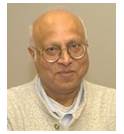
When my wife and I arrived in the US in 1973, we lived in Salt Lake City, Utah. I was a graduate student at the University of Utah and my wife Shobha was a graduate student at Brigham Young University. A Mormon land through and through. I could write many anecdotes about our experiences while we pursued our PhD degrees, but recent events in the body politic of the USA take my mind elsewhere.
During our four years of living in Salt Lake City, we watched with awe and wonder the narrowly missed impeachment of President Nixon. Such a thing was so much against the very grain of our cultivated reverence for Prime Ministers, Presidents, and many other past and present figures of national importance. It taught us what democracy is all about and we said to ourselves, “If only Indians stopped chanting ‘Indira is India and India is Indira!’”
The year 1976 was the 200th anniversary of the Declaration of Independence of the American colonies from England. We were bombarded by the conviction deeply rooted in the American psyche that “the American Constitution is divinely inspired.” In India, the only divinely inspired words are the four Vedas. It was also the time that the ERA (Equal Rights Amendment) was on its way to being ratified in several states of the USA.
Move forward to 2022. Despite the abundantly proven fact that there is not a grain of truth in ex-President Donald Trump’s irrational and evil claim that the 2020 election was stolen from him, he and his allies in the House and the Senate in Congress are unfailingly bent upon bombarding the whole country with that Goebbels-style lie (Goebbels was Hitler’s Minister of Propaganda, whose mantra was, “A lie told once remains a lie, but a lie told a thousand times becomes the truth”.) With the ex-President’s continued hold on a vast cross section of Republican voters, the “divinely inspired” constitution is increasingly becoming a sorry victim.
When I look at all this, it makes me think that a nation may land a man on the moon and a robotic explorer on Mars; but its primitive reptilian brain simply refuses to become sophisticated. And right now, that reptilian brain is on hyperdrive! ∎
The landmark Roe v. Wade decision of the Supreme Court of the United States in 1973 had remained unshaken until now. But it did not survive the majority opinion of the current Supreme Court. As if that was not cruel and evil enough (see the lead article by Premlata Venkataraman), one of the six justices who ruled to overturn the Roe v. Wade landmark decision of 1973 has further suggested that the Supreme Court should also reconsider several constitutional rights!
Obituary: Mani Balu (1935 – March 28, 2022) Soft-Speaking Pediatrician, Helpful & Caring
Posted by admin in July 2022, Past issues on July 7, 2022
By Sudha Dixit, Wexford, PA
Sudha Dixit, a long-time friend of Mani Balu, lived in Uniontown before she and her husband moved to Wexford. With her husband Niranjan practicing medicine, Sudha lived in Uniontown for decades as Mani Balu’s neighbors.
Dr. Mani Balu, a long-time resident of our area who practiced pediatrics in Uniontown for several decades, suffered a cardiac arrest on March 28, 2022, and passed away even before the emergency medical staff arrived. He was 87.
Mani Balu was the youngest of six siblings, born in 1935 in Thoothukkudi in Tamil Nadu. Mani completed his medical degree at Kilpauk Medical College in the late 1950’s. He was posted as a civil assistant surgeon for Tamil Nadu in various small towns. He married Shantha in 1961. They had two children, Ravi, and Latha, while in India. The Balus came to the United States in 1968, with Mani wanting to train in pediatrics. He studied pediatric endocrinology in New York’s Queens General and Long Island Jewish hospitals. After completing training, the Balus moved to Big Stone Gap, Virginia. Later, in 1993 they moved to Uniontown, PA, with Mani joining Dr.Thomas D’Auria to practice pediatrics. After Dr. D’Auria’s retirement, Balu continued and expanded the practice in Uniontown, with three pediatricians joining him.
Dr.Mani Balu retired from his practice in Uniontown in 2015 and moved to Monroeville to be close to their son, Ravi Balu. In his retirement, Mani Balu annually went to Chennai and spent several weeks in Chengalpattu, treating leprosy patients. With Shantha’s dedicated support, he silently continued his philanthropic work there from his own resources, be it for leprosy relief efforts or funding education for young girls and underprivileged children.
Balu was an avid reader of the classics and Hitchcock. He was an ardent fan of Raj Kapoor songs and cricket. With his friends practicing medicine in Uniontown, Balu would watch cricket matches and travel to many places. Personally for me, Balu was my Pediatric Help Hotline while we were helping our daughter raise her two children. Mani Balu was known for his humility, generosity, compassion, and openness towards his friends. The Balus bore their painful personal losses with stoicism, fortitude, and resignation.
Dr. Mani Balu leaves behind his wife Shantha, and his son Ravi Balu, his daughter-in-law Raji, his two grandchildren, and a large number of his friends. Mani Balu was cremated on March 29, with Pandit Gopala Bhattar helping Dr. Balu’s son, Ravi, with the Vedic cremation rites. Dr. Mani Balu’s family organized a memorial service in Monroeville in early April with a number of his friends in attendance. ∎
From the Kolis (कोळी) to The Wholey’s — A Seafood Story
Posted by admin in July 2022, Past issues on July 6, 2022
By Deepak Kotwal, Squirrel Hill, PA
In early June, Deepak Kotwal, a Maharashtra native and a seafood connoisseur, visited Wholey’s in the Strip District to write about their business and how they cater to the seafood lovers in our area. Note: The Kolis (कोळी) are the Marathi fishing community that dominates seafood harvesting and trading in Maharashtra.
When Indians first settled in the Pittsburgh area in the 1960s, pescatarian Indian immigrants from Mumbai and coastal regions of Maharashtra savoring paplet (pomfret,) bombeel (Bombay-duck) and surmai (kingfish), and the macher-jhol-loving Bengalis, whose favorites are hilsa and rohu, and from all over the peninsular and other regions of India were thrilled to “discover” Wholey’s in the Strip District. They are the largest seafood retailer in Southwest Pennsylvania. Local supermarkets then did not have much of a seafood section. Until fish-loving Indians in and around Pittsburgh found out about Wholey’s, their options were frozen fish sticks and canned tuna to whet their cravings for seafood.
The word Koli (कोळी) in Marathi refers to the traditional Marathi fishermen community that dominates the seafood harvesting and trading business in Maharashtra. My childhood memories include shopping for fish and price-haggling, mostly unsuccessfully, with the kolanīs (कोळणी), the kolī women who managed the retail sales. Their men were on the seas harvesting their catches or getting ready for their next fishing expedition. My daughters’ childhood memories here include going to Wholey’s and holding a slippery smelt in each hand.
Besides ethnic identity, religion, language and clothing, food is an important marker of one’s cultural identity. The late Anthony Bourdain, the famed chef, author, and TV culinary travel host, showed through his TV shows, how to understand cultures through their food.
Here in the US, a land of immigrants, by necessity, new arrivals quickly adapt to the morés of the land to blend in. They switch to local clothing. Their children lose proficiency in their mother tongues in one or two generations. But they continue their culinary traditions passing them on to their children. Childhood food and taste memory is a powerful force.
There is a perception outside India that most Indians are vegetarians. But with its 7,000-plus kilometer coastlines and 400-plus rivers with over 12,000 miles of rivers and countless ponds and lakes, it is natural that seafood is a major part of the Indian diet. There are many references in old Sanskrit and Tamil literature to all types of fish and other aquatic creatures and fishermen communities. In 2000-plus year-old Tamil classics, neithal (ெநய்தல்) is the term for seashores, having unique landscape features, human settlement and activities. Here is a website listing the Indian names for a variety of different fish types: www.tinyurl.com/Fish-names-in-Indian-Languages As an aside, in India, Bengali brahmins and Saraswat brahmins in Maharashtra are seafood connoisseurs. Why some brahmins are vegetarians and others are not is a topic for another article.
Recently, I visited Wholey’s in the Strip District to inform readers of a whole range of seafood items at the store. I spoke to John McNally, a purchasing and marketing veteran with Wholey’s, and Muriel Maze, who joined the Wholey’s recently, to learn more.
In 1912, Robert L. Wholey, from an Irish immigrant family in McKees Rocks started a food distribution company dealing with poultry, meats, sausages, and coffee. His son Robert C. Wholey in 1948, after returning from his military service in WW-II, started a live chicken store in what was then known as “Diamond Market” in downtown Pittsburgh.
In 1959, the Diamond Market was converted to the current up-scale Market Square, forcing their poultry and meat-related business to move to the Strip District. It was a difficult business decision since theirs would be the first retail food store among all the wholesale shops there. It is a truism that successful businesspeople listen to their customers. Around 1960, a customer who had gone to the Chesapeake Bay area came to Mr. Robert Wholey with a large catch of crabs and asked whether the Wholey’s would put them up for sale in his store; they did. Sensing an opportunity, Wholey’s added a fresh seafood section. The rest, as they say, is history. Today, Wholey’s sources their seafood from all over the world. They even have a cooked food section as well, the most popular item being their fish sandwich.
The Wholey’s has a significant customer base from among the people of Indian origin living in this metro area. John explained that Indian customers like to buy the whole fish and have it cleaned by the store’s skilled staff. Fish cleaning requires special skills and there is in-store training for the job, which commands better pay, and has a much lower turnover rate. We chatted with Mr. Yum Duong, a fish cleaning specialist with the Wholey’s for over 20 years, an immigrant from Vietnam. He is well tuned into how to prepare fish steaks, bone-in, for the Indian market.
The fish types popular among Indians are bronzini, blue fish, sea bass and catfish among others. Also popular are butterfish, a small fish that is cooked whole. Pompano and flounder remind us of paaplet (pomfret.)
The local American population sticks to boneless fillets, as most do not know how to cook and eat a whole bone-in fish. Indian immigrants who learnt to eat fish in India know that bone-in fish preparations are tastier than boneless fillets.
Raw shrimp sold at Wholey’s, as in most of America, is head-off (that is, with its head cut off). Most of the shrimp’s fat is in its head. So, when the shrimp has its head on, it tends to become mushy. Headless shrimp can retain their original crispness and texture because of the absence of fat and is preferred by Americans.
In the late 1970’s, a few fish-eating friends of ours would order head-on whole shrimp from Louisiana. We woulde pick up the 50-lbs dry-ice-packed Styrofoam box at the airport, and split the huge shipment. For a true fish-lover from India there is nothing more delectable than sucking on a curried shrimp head! I know, I know, some of you, who are used to eat shrimp the American way are probably repulsed by this. But then, food, like beer, you will agree, is an acquired taste!
When I buy a whole flounder at Wholey’s and have it cleaned at the store, I always request the cleaner to check for egg sacks inside. These egg sacks are an Indian delicacy, but routinely thrown out here.
There are those Indian immigrants who were vegetarians back home and have switched to eating fish after coming here. They learnt to eat fish in restaurants, always served as boneless fillets. These Indians generally do not like whole fish prepared bone-in and with Indian curries and spices.
Climate change, increased world demand for seafood and improvements in the mechanized fish harvesting technology have led to overfishing. While per-capita meat consumption shows a downward trend in the developed countries for health reasons, seafood consumption has increased. Naturally, some species are near extinction. Fish-farming may be the savior of some of these species. Given the increased demand for seafood, flagrant violations of international agreements to limit catches are common. The Marine Sustainability Council (MSC) and the National Oceanic and Atmospheric Administration (NOAA) are working to promote sustainable practices. Whole Foods uses a red/yellow/green rating of MSC. John McNally at Wholey’s assured me that their policy is to sell only sustainable species. It is incumbent on all pescatarians to ensure that the seafood they consume meet the level of sustainability.
The fish-loving Indian immigrant community here and Wholey’s have a symbiotic relationship: the former wanting to fulfill their desi cravings of seafood, and the latter, wanting to find a new market segment for expanding their business. The Wholey’s in the Strip District ensures that despite Pittsburgh not being on either coast of this vast country, it is not a gastronomic wasteland in the sphere of seafood delectables. ∎
Juginder and Dolly Luthra, Well-Known to Patrika Readers, are Moving to New Jersey
Posted by admin in July 2022, Past issues on July 6, 2022
By Kollengode S. and Prema Venkataraman
Juginder and Dolly Luthra, long-time residents of Weirton, WV and well-known to Patrika readers and the Indian diaspora here, are moving to New Jersey, to be close to their daughters and grandkids, in their retirement. This is a trend among Indians in their autumn years.
“There is a pang of sadness in leaving the community,” said Dolly Luthra wistfully, continuing “even as we are happy to look forward to spending more time with our grandkids.”
They raised their daughters and took part in social and cultural events around the city, as is usual in Indian communities everywhere. Soon they went beyond just participation. Living in Weirton close to the Greater Pittsburgh Indian diaspora, they were the patrons supporting Indian classical traditions of music, dance and performing arts.
Dolly recalled arriving in Pittsburgh over four decades ago with their 6-week-old twin daughters in a bassinet and another 4-year-old daughter in tow. They settled in Weirton WV to start their practice in healthcare — Juginder in ophthalmology and Dolly in dentistry.
Weirton in its heydays of the Mighty Steel starting in the early 20th century, attracted immigrants from all over Europe to run the thriving steel industry. The city organized an annual Festival of Nations in Spring to highlight the culture of the many immigrants. But this festival ended in 1948, after the end of WW II.
When Weirton revived the Festival of Nations in 2009, Juginder introduced Indian folk and classical dances in the festival to highlight the new immigrants from India settling in Weirton. He dipped into the resources available in Pittsburgh and enriched the Festival of Nations to include many dance traditions from Asia. Nandini Mandal wrote a story on this. (www.tinyurl.com/Luthras-Story-by-Mandal)
Both Dolly and Juginder are also well known for their artistic talents outside the narrow confines of their professions. Dolly acted in dramas. Juginder was the main lead in a 15-minute short movie titled Sunflower about getting old, directed by Ferris Rosati. Many of Juginder’s friends would recall his singing ghazal/shairis and other genres of Hindi songs.
The Luthras coauthored poems in the Pittsburgh Patrika. Juginder also authored poignant articles in the Patrika on his childhood as a Partition Child, when Juginder’s parents moved to India with their young kids leaving everything they had in Pakistan.
When we approached the Luthras to feature a story on Saroj Bahl, and her efforts to set up the India Nationality Room at the Cathedral of Learning in Oakland., they readily responded to our request. The Luthras talked extensively to Saroj and her husband Mohinder Bahl on this topic. Their fascinating account of how the Nationality Room came into being culminated in an article in the Patrika in 2009.
Similarly, they talked to Nandini Mandal in 2018 on her journey in Indian dance traditions through her challenging health situations (www.tinyurl.com/Luthras-on-NandiniMandal).
Making their marks in their professions and giving back to their communities (Weirton and Pittsburgh), while sharing their love of literature and the performing arts, Dolly and Juginder enriched the lives of people in our area that they called home for four decades.
We are sure they will be active on matters that interest them in New Jersey as well. Surely, we expect and anticipate that they will continue to use the Patrika as a platform for sharing with readers their poems and essays in the coming months and years. Please join us in wishing the Luthras good health and happiness in their new place, spending their times with their daughters and grandkids. ∎
Maestro Zakir Hussain’s Electrifying Tabla Recital Came Once Again to Pittsburgh
Posted by admin in July 2022, Past issues on July 6, 2022
By Nicholas J. Gigante, Vice President of Development Pittsburgh Cultural Trust, Pittsburgh, PA
Finally, Covid-related restrictions were receding further in our rear-view mirror, and we were in spring last April. In a wonderful sign that downtown Pittsburgh’s Cultural District is returning to life once again, the Pittsburgh Cultural Trust presented a return engagement of the Tabla Maestro Zakir Hussain in Triveni at the Byham Theater on April 12. Nearly 1,000 patrons came to the recital on a Tuesday and thoroughly enjoyed the performance by Mr. Hussain, the tabla superstar, performing along with Kala Ramnath on the violin and Jayanthi Kumaresh on the veena.
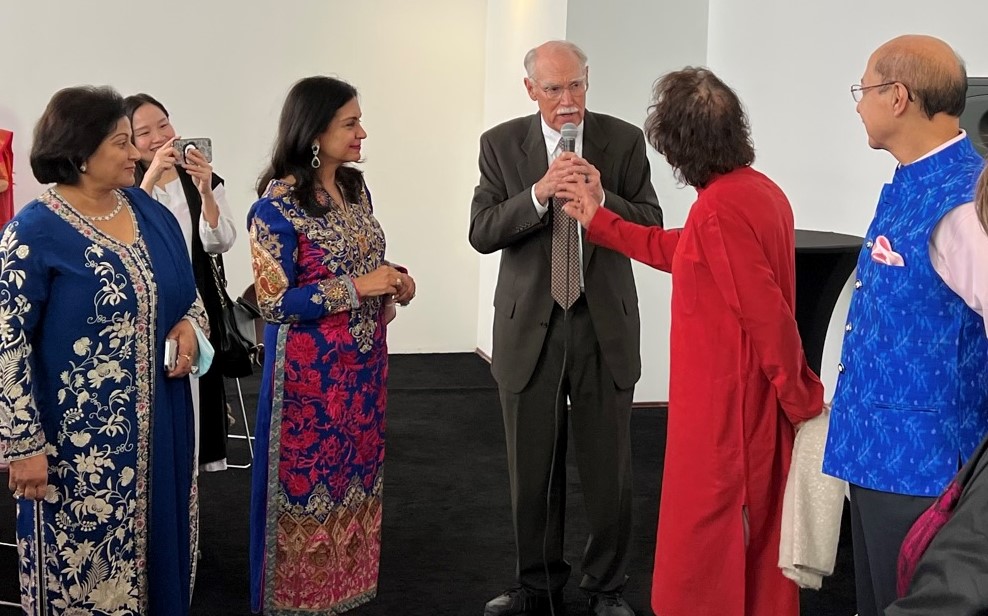
Prior to the evening recital, around fifty guests attended a special meet-&-greet with the dynamic and engaging Mr. Hussain, along with Ms. Ramnath and Ms. Kumaresh. Mrs.Nita and Mr. Sunil Wadhwani, well-known to the readers, hosted the reception in the Byham Theater’s Fulton Mini lounge, overlooking the Allegheny River. Mr. Hussain and his musical colleagues interacted with guests, posed for pictures and selfies, and signed autographs.
Mrs. Wadhwani, along with Cultural Trust President and CEO, Kevin McMahon, made remarks jubilantly welcoming Mr. Hussain back to Pittsburgh. Mr. Hussain also delivered heartfelt musings highlighting his excitement to once again be performing for live audiences, especially his devoted and enthusiastic fans.
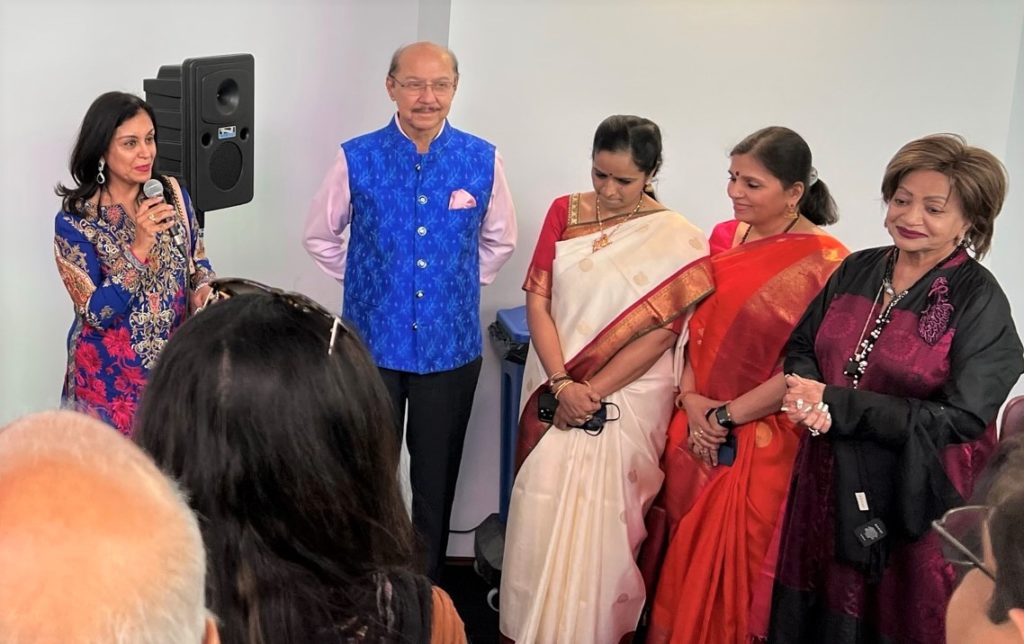
Mrs. Wadhwani is a member of the Pittsburgh Cultural Trust’s Programming Committee. Her husband, Sunil, is on the PittsburghTrust’s Board of Trustees. Also in attendance, among others, was fellow Cultural Trust Trustee, Sarika Goulatia, along with her husband, Dr. Amit Goulatia. ∎
The Regressive Reversal of Roe v. Wade
Posted by admin in July 2022, Past issues on July 6, 2022
Finally, on June 24, 2022, the Supreme Court overturned Roe v. Wade by a vote of 6-3. The 1973 Roe v. Wade ruling was given, interpreting that the “Due Process Clause” of the Fourteenth Amendment to the Constitution gives a fundamental “right to privacy” protecting a woman’s right to opt for terminating her pregnancy (aka abortion). The overturning of the 1973 decision was expected for weeks — social media was abuzz that it would be struck down, and the death watch was already in place.
This latest overturning of the 1973 ruling will cause a tectonic shift in all these rights and even beyond. The 1973 Roe v. Wade decision went beyond abortion: it included the right to contraception as well. Many states in the South, where social and religious conservatives run the government machinery, had already started imposing restrictions on abortion.
Striking down Roe v. Wade has always been in the campaign promises of many Republican presidential and congressional candidates in elections. But it gained momentum during the Reagan presidential campaign in 1980. It was ironic that the B-grade Hollywood actor, Ronald Reagan, in the 1980s, made this a campaign promise when running against Jimmy Carter, an Evangelical Christian, to woo the religious conservatives led by the Rev. Jerry Falwell. And Reagan struck gold!!
Ever since, every Republican presidential candidate has promised to appoint judges to the Supreme Court to strike down Roe v. Wade to appeal to social/religious conservative voters. Of course, the maverick Republican Donald Trump appointing three justices to the Supreme Court made this easy. Nobody will miss the irony that the thrice-married Trump, a playboy with a promiscuous, unrestrained, philandering — you pick the adjective — lifestyle throughout his adult life, made this happen! Predictably Trump took credit for the decision, keeping the 2024 presidential elections in mind: “Today’s decision, which is the biggest win for life in a generation … was made possible because I delivered everything as promised.”
Americans have always been divided on the issue of abortion. Those opposed to women’s need to have the options on reproductive matters prophesied that rates of abortion will rise and promiscuity among teenagers would lead to more pregnancies. Much to their chagrin, this did not happen (see the graphs). On the contrary, better sex education and dissemination of correct information resulted in fewer teenage pregnancies.
Similarly, as working women focused on their careers, the birth rate too declined. The blame for this is the abysmal state of paid maternity/paternity benefits and the prohibitive cost of childcare for working class families.
Some states rushed to ban abortions altogether (the count is now seventeen) and many more will join them in the coming months. Now, in many of these states, abortions will be accessible only to those women with money to travel to states where abortion is still available, who have the resources to pay for the service and stay in hotels, costs that may run into a few thousand dollars. But abortion numbers are closely tied to the poverty level of women. See the table below:
Low-income rural and urban women of all ethnicities in the American context, who cannot afford to pay for the abortion, are the biggest victims of the US Supreme Court decision. These women, already burdened with low wages and higher unemployment with less access to medical facilities, will be victimized for this over-reach of the Supreme Court.
In the post-feminist era, a new generation of women took the victories of the feminist movement for granted. With better access to education and better paying jobs, many felt complacent about the freedoms they enjoyed. They will have to start the struggle all over again to gain control of their reproductive rights. Now, there will be a new respect for the earlier feminists who fought and won concessions to gain control of their reproductive rights — from sex education/contraception to abortion.
So, where are we headed from here? For starters, restrictions to abortion in many states are likely to increase the serious complications for women and infants during childbirth. Further, where abortion is not legally available, outcomes for medically high-risk births will result in dangerous situations, mostly for low-income, less educated women. This should be of grave concern for public health administrators, irrespective of their ideology on women’s reproductive rights.
Fixing this problem requires a long-term outlook. Electing more women who are pro-choice — not just in Congress, but also in state and local government — is necessary to bring women’s issues into public focus. Not just reproductive rights, but paid maternity/paternity leave, and helping families with childcare costs.
What should young parents do now? It is important now more than ever that parents with young children take on the important duty of educating their daughters and sons as well — and particularly sons, one might say — on their personal responsibilities in their interactions with their peers of the opposite gender. Discussing openly and freely in the home in one-on-one discussions and in schools is imperative for saving our children from the horrible consequences of pregnancies when they are themselves children.
This regressive decision by six judges of the Supreme Court, prompted solely by their partisan politics and conservative ideology, is deplorable to say the least. Deplorable because this decision
a) reverts an already settled issue,
b) is intrusive in our cherished right to privacy,
c) completely ignores the widely available socioeconomic statistics of unwanted pregnancies that are cruel to the working class and poor disadvanged women of all races and color, and
d) overlooks the advances in medicine in detecting serious fetal defects resulting in a huge burden on all women, families, the healthcare system, and taxpayers when women are forced to carry to terms their high-risk pregnancies. ∎











